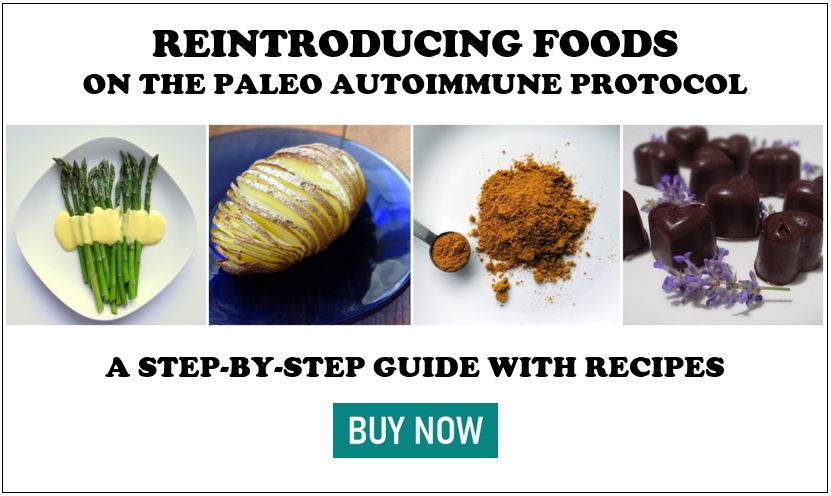“Knowing yourself is the beginning of all wisdom.”
~ Aristotle
This Interview Series
Reintroducing Foods on the Paleo Autoimmune Protocol was my first e-book, which I published back in 2014. I realized that the reintroduction process is often the trickiest part of the AIP journey. It can be confusing, overwhelming, and hard to navigate alone. I wrote the book to guide people through, and thereafter got a nickname: Reintro Goddess. (Just kidding, but wouldn’t that be a great nickname?) I’m passionate about this process for two reasons: (1) Some people make the mistake of thinking the elimination phase of the AIP is meant to last forever. It’s not. It’s just the first step. The next step is personalizing the diet for you. (2) The reintroduction process is an experiment with you at the center, where you learn to communicate clearly with your body, and it’s incredibly empowering! Everyone’s reintroduction experience is unique. I thought it would be inspiring and educational to interview people who have been through this process themselves.
Introducing Angela Horswill
Angela has multiple autoimmune diseases, including lupus, celiac, and mixed connective tissue disease. The paleo autoimmune protocol has been an essential part of her healing journey.
- How long did you do the elimination phase? 6 months.
- How did you decide that you were ready for reintroductions? In one word: fear. To expand on what I mean by fear, I did the AIP diet for six months and noticed some benefits like better digestion and fewer rashes. However, I also realized I was starting to have some food anxieties, and going to restaurants was increasing my anxiety levels. I wasn’t able to enjoy the meals and company, because I was nervous a nightshade or other non-AIP food item could be in my meal by accident. In addition, I was preparing for vacation and decided for that reason, as well as my mental health, to start reintroducing foods. After all, the AIP is meant to be a temporary protocol not a permanent one.
- What foods have you been able to successfully reintroduce? Green peas, green beans, most nuts, seeds, cocoa, egg yolks, nightshades, rice, corn, gluten-free instant oats, lentils and dried beans (if soaked overnight and cooked in a pressure cooker).
- Which ones can you eat regularly and which ones just occasionally? How did you discern the difference? I can regularly eat green peas, green beans, most nuts, seeds, cocoa, egg yolks, gluten-free instant oats, and legumes/lentils. Walnuts are the one nut that I don’t tolerate well. I also have to limit corn, nightshades, and rice. I noticed when I would have the same foods over and over I would get some reactions. However, if I only ate them once or twice a week they were fine. Also doubling up on nightshades like chili with tomatoes for lunch and then taco salad for dinner, was just too much in one day. I have found there is a threshold for my reactions, and I try to stay within the unreactive zone. The same is true for me with natural sweeteners, like honey. I can have a little, but not a lot.
- When food reintroductions failed, what were your symptoms? Some reactions were apparent right away while others were harder to discern. Egg whites caused immediate joint pain. With nightshades, it was a slow building of joint pain over a period of 2-3 days when I ate too much. The pain was localized in my feet, hips, hands, and elbows, and also increased my peripheral neuropathy. The more I ate the worse my pain would get. Walking barefoot from the bed to the bathroom would be torturous for my feet without shoes on, and trying to straighten my arms was extremely difficult and painful in my elbow joints. Corn was complex and presented difficulties when confirming it as an irritant because it didn’t affect my joints. Instead, it caused digestive and mood issues: bloating, a decrease in motility, and increased anxiety. But it took time. I ate corn daily for 5 days before it gave me a response. I’ve tried reintroducing it again occasionally (2-4 times a month) and it seems to be fine in smaller doses. When I reintroduced nuts I didn’t have an issue with them until I tried walnuts. Walnuts gave me mouth sores, mouth burning, and upper palate soreness. Eileen’s Editorial Note: This is why I include a 2-phase reintroduction process in my book, The Paleo AIP Reintroduction Guide. If you don’t get an acute reaction within 72 hours of the first reintroduction, you eat a little bit of the food daily for a week to determine which foods you can eat regularly vs. just once in a while. Angela did this perfectly.
- Did any reintroduction failures later become successes? When I reintroduced gluten-free oats, I found that I had a terrible time digesting it and had a lot of bloating and rumbling noises, even in small amounts until I tried two particular brands: Glutenfreeda and One Degree. These are certified gluten-free instant oats and do not bother me at all. When I first tried nightshades, I had symptoms including joint pain, peripheral neuropathy, increased sensitivity to pain, and anxiety. I reintroduced those again on vacation and had no issues, so occasionally I have some nightshades. While writing this, I’m reminded that nightshades continue to give me issues which is why I don’t eat them often. However, I still want to keep them in my diet for variety and flexibility at social functions or summer BBQs. Eileen’s editorial note. This vacation effect is very common. Since digestion starts in the brain, stress can decrease food tolerance while relaxation can sometimes expand it. Listen to my podcast on Mind-Body Nutrition, to learn more.
- Have you reintroduced any non-paleo foods? If yes, which ones and how often do you eat them? Rice, gluten-free instant oats, lentils and beans. I eat about two servings of each weekly.
- Is there any food you’d never reintroduce? I did not even try to reintroduce dairy/ghee, because I did 5 years ago while on vacation and it was a disaster trying to digest it. It’s certainly not worth trying again. Although I love the taste and smell of coffee, I’ve known for a long time that it causes negative symptoms for me: anxiety/panic attacks, lack of concentration, sleep disturbances, and increased sensitivity to cold temperatures. Unless I am under a lot of stress, green and black tea typically do not contribute to any of the above symptoms so I stick to those. And due to my medication, I can’t have alcohol.
- What affects your food tolerance? When I am having a flare, or haven’t had enough rest, or skip my exercise or other self-care treatments, I become extremely sensitive to nightshades, sugar, caffeine and corn.
- Have you ever done an AIP reset (where you did the elimination phase over again)? If yes, what was the motivation, and did you find it helpful? I haven’t done an entire AIP reset. However, during flares I have taken out the major aggravators including all nightshades, some nuts and honey. Once the flare subsides I reintroduce the honey, nuts, and then the nightshades in that order.
- Are there any foods allowed on the AIP that you discovered you don’t tolerate? Yes. At first, I was unable to tolerate sauerkraut, bone broth, kombucha or collagen supplements. I’m still unable to digest most of those, but I can now have some kombucha. I’m also sensitive to caffeine and discovered that black tea caused anxiety attacks, so I pulled it out of my diet and just drank green tea. When I went on vacation I tried black tea again and had no issues. Now I can drink 1 cup of black tea daily when I’m not having a flare-up. Lastly, I have a strong negative reaction to citrus: rashes, itching, mouth irritations, and it can also have a laxative effect for me. Eileen’s editorial note: While most people tolerate these foods well on the AIP, trouble with these foods can sometimes indicate Histamine Intolerance. Listen to Episode 36 of my podcast to learn more.
- What was the hardest part for you about the reintroduction process? Anxiety and worrying. Worrying I would have to live on AIP forever, but anxious to start the reintroduction process and get off of the restrictive diet. The hardest part was taking that first bite and waiting for some type of noticeable difference in my body and mood. When it didn’t happen I was thrilled, and that gave me the confidence to re-introduce other foods.
- What’s your advice for people contemplating reintros, or just starting their own reintroduction journey? I highly recommend using Eileen’s reintroduction guide when you decide to start the reintroduction process. It is a very simple step-by-step guide to help you reintroduce foods. It’s the guide I used and it really helped me because it described the 4 stages of reintros, included recipes, and also had a sample symptom journal that was vital for me to keep and track symptoms. Another suggestion is to not start the reintros when in the middle of changing medications or supplements. Certain side effects like nausea, headaches, itching, etc. can be medication and not food sensitivities. Lastly, try not to think of failed reintros as a negative; considerate it a positive result: your body is giving you a signal. Having that connection with your body is a great thing!
One Last Word of Advice
Each person’s food reintroductions are unique, so don’t expect your results to be the same as above, even if you share the diagnoses. It’s fun to learn about each other’s experiences and be encouraged by them, but this is all about learning to listen to your own body. Use the resources below to learn how to do the reintroduction process yourself.
Paleo AIP Reintroduction Resources










